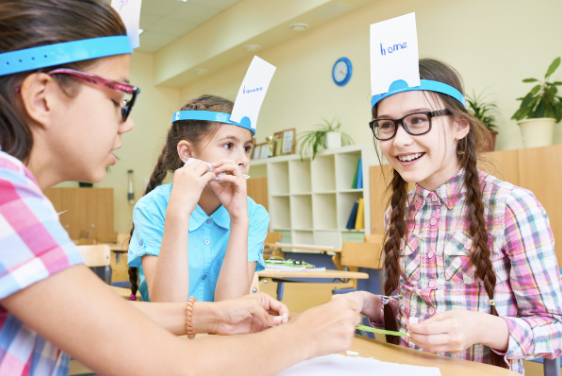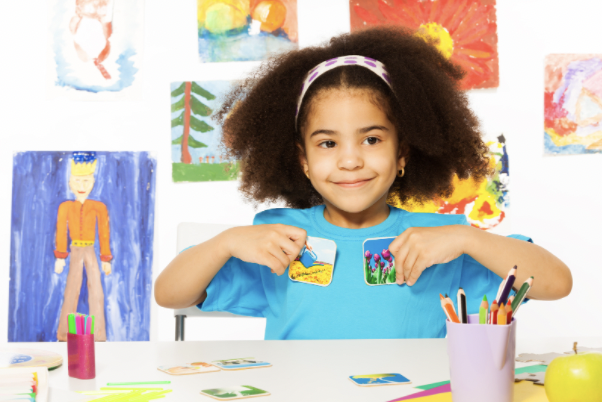One of our favorite ways to support language development during the preschool years up through the school years is through game play! We know that children are more engaged and motivated when they are having a good time, and luckily there are many games we can use. I’ll outline a few different types of games we often use in the therapy session that can also translate to home use, and I’ll also provide some options for totally free games to play with your children. My 3 favorite types of games to use for speech/language development are:
- Guessing/describing games
- Storytelling games
- Persuading games
You can click on the green links to purchase the games for yourself!
Guessing/Describing Games
Guessing/describing games are a great way to work on improving descriptive language, utilizing longer sentences, being able to define words, and being able to make inferences, or smart guesses, about what is being said.
Here are some examples:
- Hedbanz: The idea of this game is to put a card that you cannot see above your head, and then to ask questions about the card in order to guess it. For example, “Am I an animal?” “Do I live in the water?” For younger children, I like to play this game by having the other game players provide clues (e.g., “This is an animal that swims in the water, and it has a shell.”). It’s a great game for both describing and guessing
- Guess Who: With this game, each player has a person card, and other players ask questions in order to eliminate other people to pinpoint the person on the card (e.g., “Does your person have red hair?”). This is a great way to work on asking questions, as well as making smart guesses. For example, if the player says, “No, my person does not have red hair,” you need to eliminate all the people with red hair.
- Barrier games: Barrier games are games in which players are sitting with a barrier in between them. The classic game Battleship is a good example. We like to play barrier games in order to create a picture scene. In one version, each person has the same picture scene on either side of a magnetic easel. Magnets are placed in the same position by giving the other player directions (e.g., “Put the crocodile in the center of the river, at the bottom.”).


Free describing/guessing games:
- I Spy– describing items in the environment instead of just the color. Or, take it a step further, and describe items that are not present in the environment.
- 20 Questions
- Barrier game– place a barrier in between two players, and try to draw the same picture or make the same block creation, just by giving each other directions.
- Categories– Pick a category (e.g., fruits, things you wear) and pass a ball back and forth while listing items in the category. The last person to be able to think of another item in the category is the winner.
Storytelling Games
Storytelling games are super for narrative language skills such as identification of characters and setting, using a clear beginning, middle, and end, and working on retelling the story afterward.
Here are some of our favorites:
- Create a Story cards: these are picture cards with characters and scenes that recur but change slightly, so they are great as story starters. You can take turns with your child adding on to the story, or have your child create it on their own.
- Rory’s Story Cubes: these are similar to the Tell Me a Story cards, in that they have an image designed to elicit a part of the story, but the images are much less specific and detailed, so imagine plays a bigger role.

*Free story-telling games:
- Turn-taking stories– you or your child starts a story. Each person gets to add on one sentence, so the story may change significantly from what you originally planned. For older children, a fun challenge would be to limit each turn to 1 word, or just a few words.
- Dice stories– similar to turn-taking stories, but on each turn, a player uses a die or dice to determine how many words they get to add to the story.
Persuading Games
Persuading games are a great way to work on language planning, sentence formulation, back-and-forth conversation, and agreeing/disagreeing.
Here are some of our favorites:
- You Gotta Be Kidding! The Crazy Book of Would You Rather” Questions: at Emerge we have the board game from this company. The game is out of stock, but these questions are similar. You can take turns asking and answering the questions. For extra language work, explain your choices to each other, and try to guess what the other person would choose.
- Lion in My Way: work together to make it home past various obstacles. You choose a “tool” to utilize (anything from a vacuum to a box of chocolates). Take turns convincing other players why your tool would be the best. It’s also a great game to work on compromise.

*Free persuading games:
- Would You Rather questions– you can find tons of ready-made lists online, or work on coming up with your own.
- Debate– choose a serious or silly topic (e.g., T-rex v. Stegosaurus) and debate why one is better than the other. For an extra challenge, switch sides midway through.
Blog post written by Kelly Goad, MA, CCC-SLP

0 Comments